RED THAI CURRY
March 10, 2025
Red Thai curry is my favorite go-to dinner during the week—it’s quick to make, packed with bold flavors, and makes for delicious leftovers. The rich, creamy coconut milk balances the heat from the red curry paste, creating a perfectly spiced dish that’s both satisfying and comforting. With a mix of fresh vegetables, tender protein, and fragrant herbs, every bite is full of warmth and depth.
Eating Curry when sick?
Spicy foods like curry can be incredibly soothing when you’re sick, helping to clear congestion, fight inflammation, and support your immune system. Ingredients like turmeric, ginger, and garlic provide natural antibacterial and anti-inflammatory benefits, while the heat from spices can ease a sore throat and aid digestion.
This curry comes together in only one pot and about thirty minutes, making it ideal for busy weeknights when you want something homemade without spending hours in the kitchen. The vibrant blend of spices and aromatics gives it an irresistible depth of flavor, while still being able to find all the ingredients at your local grocery store. Whether you’re looking for a cozy meal to wind down with or a dish to impress guests, this Red Thai curry is always a winner.

Contents
Ingredients
Avocado Oil: Avocado oil is used to bloom the curry paste, enhancing its depth of flavor while also helping to cook the chicken to tender perfection. Its high smoke point makes it ideal for sautéing, ensuring the spices and aromatics are fully released without burning.
Chicken Breast: Chicken breast provides a lean and tender protein that absorbs the rich flavors of the curry sauce while staying juicy. Though the protein can be substituted for steak, shrimp, or replace with more vegetables.
Red Curry Paste: Red curry paste is the heart of this dish, providing a bold, aromatic base with its blend of red chilies, garlic, lemongrass, and spices. Blooming it in oil helps release its deep, rich flavors, infusing the entire dish with a perfect balance of heat, sweetness, and savory depth.
Ground Turmeric: Turmeric powder adds a warm, earthy depth to the curry while enhancing its vibrant golden hue. Its subtle bitterness balances the richness of the coconut milk and complements the bold spices in the dish.
Curry Powder: Curry powder brings a warm, aromatic blend of spices that deepens the flavor of the dish. Though optional I believe the extra curry flavor adds more warmth and complexity to the final product.
Yellow Onion: Yellow onion provides a sweet and savory foundation for the curry, adding depth and richness as it cooks down. Its natural sweetness enhances the bold spices, creating a well-balanced and flavorful base for the dish.
Bell Pepper: Bell peppers add a pop of color, natural sweetness, and a slight crunch to the curry. Their mild flavor complements the bold spices, while their tender texture balances the richness of the sauce.
Grated Ginger: Grated ginger brings a warm, zesty brightness to the curry, enhancing its depth of flavor with a subtle heat. Its fresh, slightly spicy kick balances the richness of the coconut milk and complements the aromatic spices in the dish.
Garlic Cloves: Garlic cloves bring a rich, savory depth to the curry, infusing the dish with their bold flavor. As they cook, they soften and blend perfectly with the spices, adding to the overall warmth and complexity of the sauce.
Full Fat Coconut Milk: Full-fat coconut milk creates a creamy, smooth texture that adds richness to the curry. Its natural sweetness balances the heat from the spices, while its velvety consistency brings everything together for a comforting, flavorful dish.
Arrowroot Power: Arrowroot powder is used to thicken the curry, giving the sauce a velvety consistency without altering the flavor. It’s a great alternative to flour or cornstarch, providing a light, natural way to achieve the perfect texture.
Thai Sweet Chili Sauce: Thai sweet chili sauce adds a touch of sweetness and mild heat to the curry, enhancing the overall flavor with its perfect balance of sugar, vinegar, and chili. Its tangy-sweet profile complements the spices, creating a harmonious depth of taste.
Coconut Aminos: Coconut aminos bring a rich, umami flavor to the curry, offering a savory depth without the intensity of soy sauce.
Fish Sauce: Fish sauce provides a unique, salty depth to the curry, enhancing its savory flavor with a hint of tanginess. Just a small splash brings a rich complexity that perfectly complements the sweetness of the coconut milk and the heat from the spices.
Lime Juice: Lime juice adds a refreshing, zesty brightness to the curry, balancing the richness of the coconut milk with its tartness.
Honey: Honey adds a touch of natural sweetness to the curry, balancing out the heat and tanginess from the spices and lime juice.
Dried Basil: Dried basil brings a fragrant, slightly sweet flavor to the curry. Its earthy notes complement the other herbs and spices, adding a subtle depth that ties everything together.
Salt & Pepper: Salt and pepper are essential for seasoning the curry, enhancing and balancing the flavors of the dish. A pinch of salt helps bring out the natural sweetness and richness, while pepper adds a mild heat and depth to the overall taste
Garnish: A garnish of lime wedges and fresh cilantro adds a burst of brightness to the curry. The lime offers a zesty, tangy finish, while the cilantro provides a refreshing, herbaceous note that complements the rich, savory flavors of the dish.
Variations
Optional Add-Ins
One of the best things about curry is its versatility—feel free to get creative by adding or changing the vegetables to suit your tastes. You can easily customize it based on what you have on hand or what you’re craving, while still keeping the bold, comforting flavors that make it so delicious.
- Small Zucchini – Light and mild, zucchini absorbs the flavors of the curry while adding a soft, tender texture. It’s a great way to add subtle freshness to the dish.
- Carrots – Sweet and crunchy, carrots add a natural sweetness that balances the spices in curry, while their tender texture enhances the overall dish when cooked.
- Green Beans – Crisp and slightly sweet, green beans provide a satisfying crunch and a bright, fresh contrast to the rich, creamy curry sauce.
- Spinach – Mild and earthy, spinach wilts down into the curry, adding a burst of green and a soft texture that complements the bold spices without overpowering them.
Though if you do decide to add more than just one more vegetable you might want to think about doubling the curry recipe. Do this by substituting the added vegetables for the bell peppers.
Changing Protein
If you’re looking to switch up the protein in your curry, there are plenty of tasty alternatives to chicken. Tofu is a great plant-based option, soaking up all the curry’s flavors while offering a soft, satisfying texture. Beef steak can add a hearty richness, with tender cuts like flank or sirloin absorbing the spices beautifully.
Shrimp cooks quickly and brings a sweet, briny flavor that pairs wonderfully with the bold curry spices. For a lighter, veggie-packed version, you can skip the protein altogether and add extra vegetables for a delicious, nutritious twist!
Changing Curry Paste
Changing the color of the curry paste in this recipe is an easy way to switch up the flavor profile. If you prefer a milder dish, try using yellow curry paste for a more earthy, subtly sweet flavor. For a brighter, spicier twist, green curry pastecan bring a fresh, herbal kick.
Panang paste offers a nutty richness, while sticking with red curry paste gives you a bold, classic flavor. Each type of paste will create a different experience, allowing you to customize the dish to your taste.
Ginger & Garlic
If you don’t have fresh garlic and ginger on hand, you can easily substitute with powdered versions. For 2 teaspoons of grated fresh ginger, use about 1/2 teaspoon of ground ginger. For 4 garlic cloves, substitute with 1 to 1.5 teaspoons of garlic powder. While the flavor may be slightly different, the powdered versions still bring the essential warmth and depth to your curry, allowing you to enjoy the dish without missing a beat.
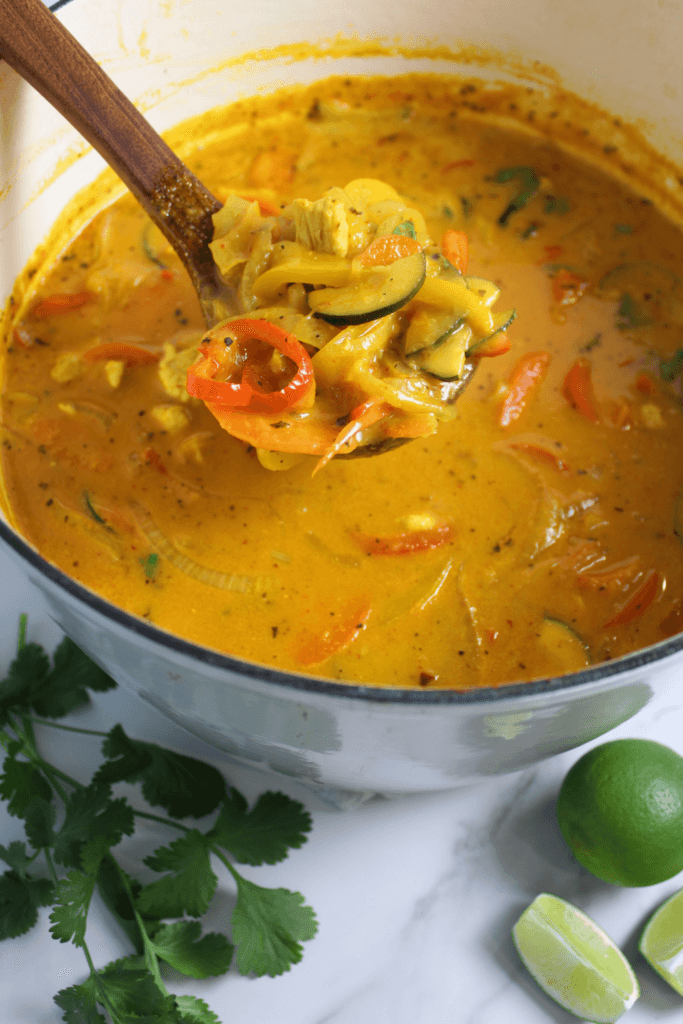
Leftover Thai Red Curry
One of the best things about Red Thai curry is that it tastes even better the next day. As it sits, the flavors continue to develop, allowing the spices and aromatics to meld together for an even richer, more well-rounded taste. Whether you reheat it on the stove or in the microwave, it’s a meal that only gets more delicious with time, making it perfect for meal prep or an easy, flavorful lunch the next day.
How to Make Red Thai Curry
1. Prepare the Ingredients
Start by prepping all your ingredients: slice your veggies, chop your protein, and have your spices and sauces ready. If you’re using fresh garlic and ginger, finely mince them, or substitute with garlic powder and ground ginger as needed. The dish comes together quick so I have found it easier to have everything ready to just dump in when ready.
2. Bloom Curry Paste with Chicken & Onions
Heat avocado oil over medium high heat and then add in chicken. Though you only want to cook the chicken till no longer pink. The chicken will continue to cook with the curry, so you dont want overcook it at the beginning.
Once the chicken is heated through then add in the onion, red curry paste, turmeric and curry powder. Stir to combine and cook down onions for a minute.
3. Sauté the Aromatics & Vegetables
Push mixture to the side of the pan and add in another tablespoon of oil to the bottom of the pan. Wait a 30 seconds and then add in remaining vegetables, stir everything together, and sauté for another two minuets. After you have cooked down the veggies a little then add in the garlic and ginger and sauté for another minute.
4. Add Coconut Milk & Remaining Ingredients
Add half of the can of coconut milk and mix remaining half in the can with arrowroot starch. Pour the rest of the can into the pan along with the rest of the ingredients except the garnishes and mix together.
Bring curry to a boil, then reduce to a simmer for about 5-10 minutes. You want the sauce to have thickened and the vegetables to have reached desired crispness.
5. Storage & Freshness
This Thai red curry recipe makes for great leftovers or meal prep. I like to store mine in quart mason jars, though any airtight container will work. Just a word of caution: avoid using plastic containers as the curry may stain them. Also for health reasons, it’s best to limit plastic contact with hot or acidic foods, as some plastics can leach chemicals over time.
The curry will stay fresh in the fridge for up to 4 days, making it an easy go-to meal throughout the week. For longer storage, you can freeze it in an airtight container for up to 3 months. Just be sure to let it cool completely before freezing, and when you’re ready to enjoy, simply reheat it on the stovetop or in the microwave for a quick, delicious meal.
Serving Suggestions
My favorite way to enjoy Thai red curry is over rice noodles—they really transform the dish in a way that traditional rice can’t quite match. That said, rice is much easier, more affordable, and still tastes great if you’re looking for a simpler option.
Types of Curry
Curries come in many forms, with Indian, Thai, and Chinese varieties each offering unique flavors and ingredients.
Indian curry is often rich, creamy, and spice-forward, made with a blend of warm spices like cumin, coriander, turmeric, and garam masala. It frequently includes yogurt, tomatoes, or coconut milk for depth.
Thai curry, on the other hand, is lighter and more aromatic, typically made with curry pastes blended from fresh herbs, chilies, and spices, then simmered in coconut milk for a silky texture. It’s known for its bold yet balanced flavors—spicy, sweet, tangy, and savory all at once.
Chinese curry tends to be milder and thicker, often made with curry powder, cornstarch for thickening, and a more subtle spice profile compared to Indian and Thai varieties.
While all curries have their charm, Thai curry is my favorite for its bright herby and zesty flavors. The combination of fresh lime, fragrant cilantro, and creamy coconut milk creates the perfect harmony of heat and freshness, making every bite irresistibly delicious.
Curry Paste Colors & Flavors
There are several types of curry pastes, each offering its own unique flavor profile. Red curry paste is made with dried red chilies, garlic, lemongrass, and spices like cumin and coriander, giving it a bold, slightly spicy flavor with a deep richness. Yellow curry paste is milder, often made with turmeric, which gives it a warm, earthy flavor and a vibrant color. It’s less spicy and has a slightly sweeter taste compared to red curry.
Green curry paste is made with fresh green chilies, offering a bright, fresh, and aromatic flavor with a noticeable heat. It also includes ingredients like lime zest, basil, and cilantro, giving it a more herbal taste. Panang curry paste is a variation that combines red curry flavors with peanuts, giving it a rich, nutty taste that’s less spicy but more savory. Each paste brings a distinct taste to curry dishes, allowing you to experiment with different levels of heat and flavor complexity.
Is Thai Red Curry Spicy?
It really depends on the ingredients you use because some curry pastes are spicier than others. For example brands like Mae Ploy can be spicy while Thai Kitchen is more mild. I personally like to mix the two by putting two tablespoons of each into my Thai red curry.
Health Benefits of this Recipe
This curry recipe offers a variety of health benefits, thanks to the nourishing ingredients it includes. The ginger and garlic are known for their anti-inflammatory and immune-boosting properties, helping to fight off infections and improve digestion. Turmeric, with its active compound curcumin, offers strong anti-inflammatory and antioxidant effects, which may help reduce the risk of chronic diseases. Coconut milk provides healthy fats that support heart health and promote satiety, while the vegetables like bell peppers, carrots, and spinach add essential vitamins, minerals, and fiber, supporting overall health. Plus, the lean protein options like chicken, tofu, or shrimp provide vital amino acids to support muscle and tissue repair. This curry is a flavorful way to enjoy a nutrient-packed, well-balanced meal. Learn More
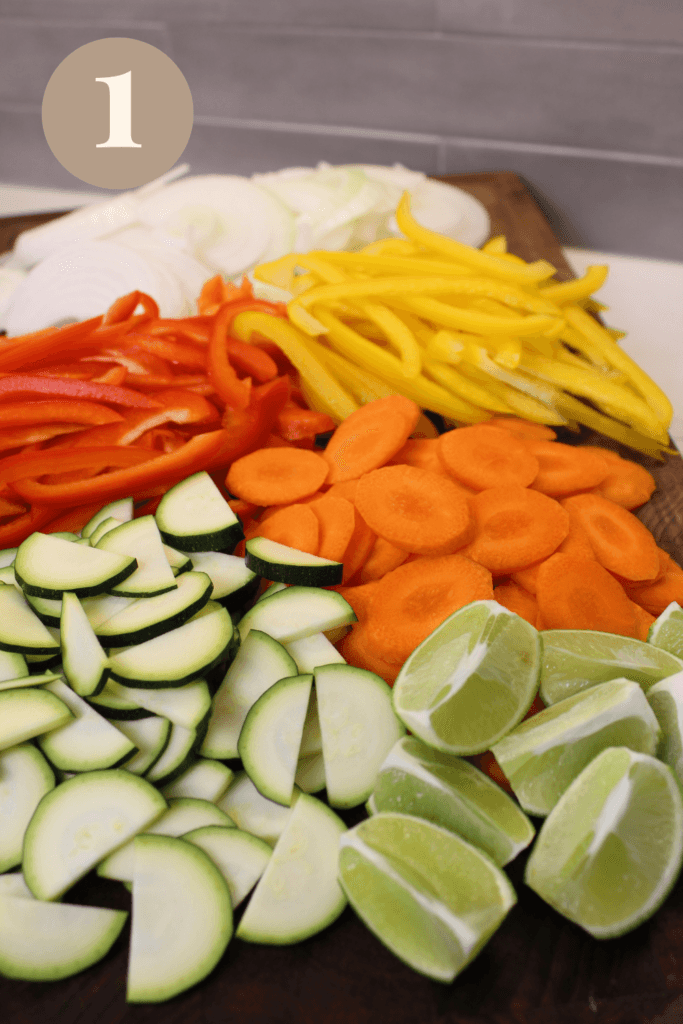
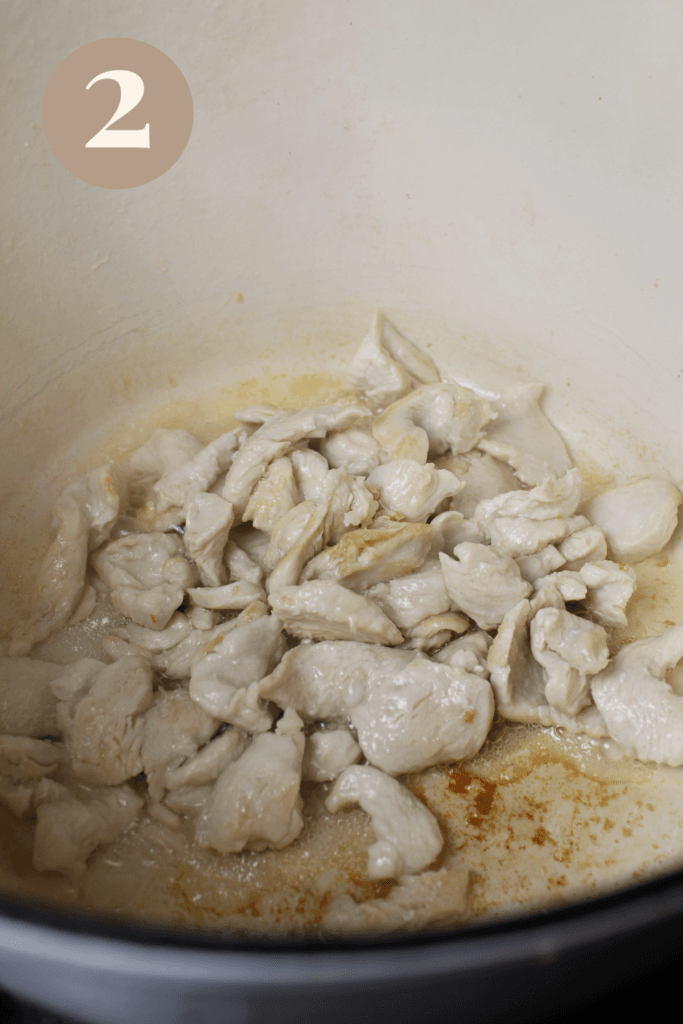

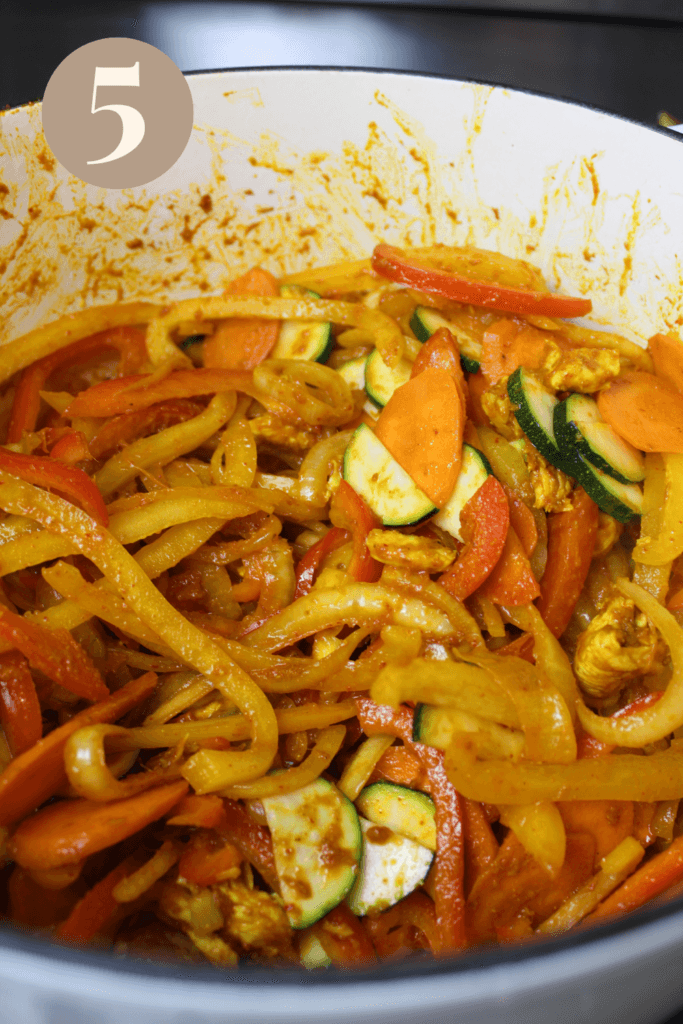
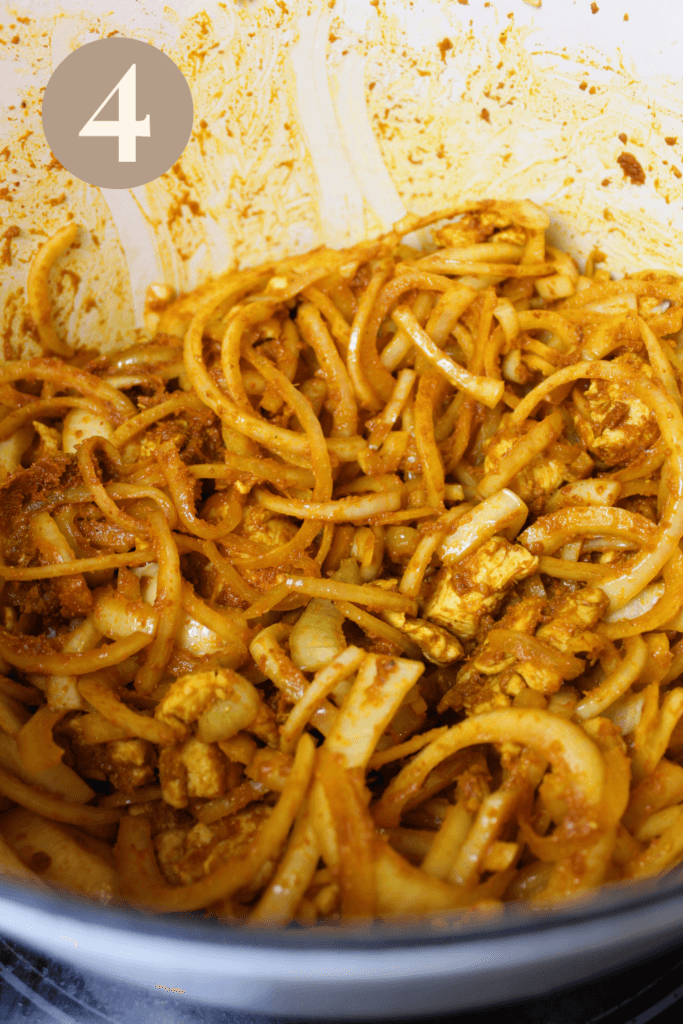
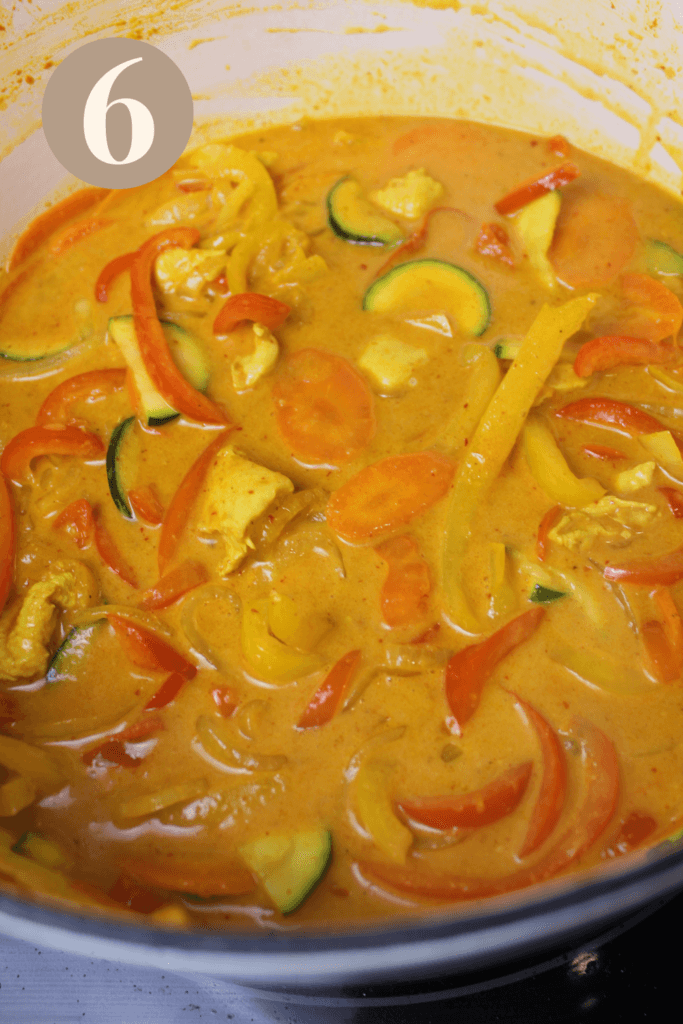
Explore some of my favorite recommended products to support your health journey (displayed on this page as affiliate links), and remember to always consult a healthcare professional before making any changes to your diet or lifestyle—full medical disclaimer here.


Thai Red Curry
Mikayla AthenaEQUITMENT
- Large Pot
- Cutting Board
INGREDIENTS
- 1 tbsp avocado oil
- 1 chicken breast sliced into 1/4" by 2" pieces
- 1 yellow onion sliced thin
- 2 bell peppers sliced thin
- 4 tbsp red curry paste
- 2 tsp curry powder
- 1 tsp ground turmeric
- 2 tsp grated ginger or 1/2 tsp granulated
- 4 garlic cloves or 1 tsp granulated
- 13.5 oz can coconut milk full fat
- 1 tbsp arrowroot powder or cornstarch
- 1 tbsp Thai sweet chili sauce
- 2 tbsp coconut aminos or soy sauce
- 2 tbsp fish sauce
- 2 tbsp lime juice whole lime
- 1 tbsp honey raw & unfiltered
- 1 tsp dried basil
- 1/2 tsp salt
- 1/4 tsp pepper
- Garnish cilantro, basil & lime wedge
DIRECTIONS
- Chop the vegetables and prep all ingredients, making them ready to add as you cook.
- Heat oil over medium heat, add chicken, and cook until no longer pink, stirring occasionally.
- Add onion, bell peppers and red curry paste to the pan, stirring to coat the chicken evenly. Sauté until the vegetables soften and cook down. Stir in ginger and garlic, cooking until fragrant.
- Pour in half of the coconut milk, stirring to combine. Next, mix the remaining coconut milk in the can with 1 tablespoon of arrowroot until smooth, then add it to the skillet along with all remaining ingredients (except garnishes).
- Bring curry to a boil, then reduce to a simmer for about 10 minutes or until the sauce thickens and the vegetables reach desired crisp-tenderness.
- Garnish with additional basil, fresh cilantro and lime wedges. Serve with rice noodles or rice. Enjoy!
NOTES
NUTRITION
Allergy Notice: This recipe is not specifically meant for celiac individuals. Instead this is meant for gluten sensitive individuals. Celiac individuals need to take extra precautions. This recipe is not meant for vegan individuals, instead for dairy sensitive individuals.
